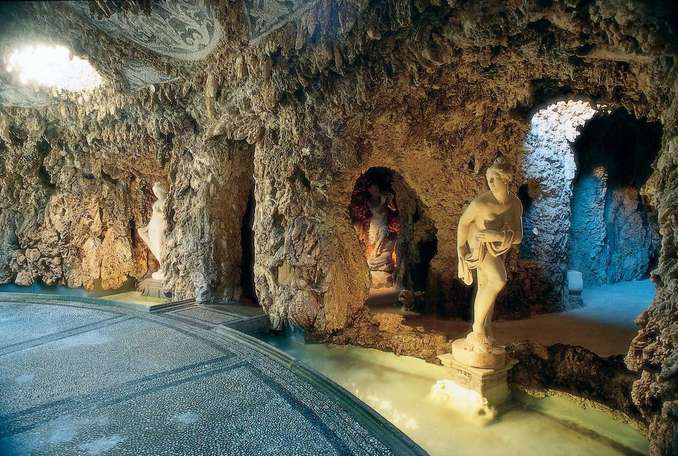
1 February 2019
Villa Visconti Borromeo Litta
Villa Visconti Borromeo Litta was built at the end of the XVI century.
Creator of the whole complex was the Count Pirro I Visconti Borromeo, who, around 1585 gave to his estate in Lainate a playful dimension, while up to that moment it was characterized by agricultural exploitation.
Outstanding patron of the arts in Milan, very widely educated and interested in different fields, Pirro I made use of the collaboration of the best Lombard artists, such as the architect Martino Bassi, the sculptors Francesco Brambilla Jr. and Marco Antonio Prestinari, the painters Camillo Procaccini and Pier Francesco Mazzucchelli (named “il Morazzone”) to transform his Lainate estate into a “place of enchantment”.
In addition to the works for the architectonic renovation of the Palace, Pirro I set the garden and built the Nymphaeum. This building can be reasonably considered one of the most important examples in northern Italy for the abundance of decorations and for the variety of its water , that also today enjoy the visitors during the summer. The Nymphaeum consists of a series of rooms decorated with mosaic and with artificial grottoes. It was meant to collect the Count's enormous art collection.
In the years immediately following 1721, Giulio Visconti Borromeo Arese, built the west Palace or “Quarto Nuovo”.
Around the middle of the XVII century, the Marquis Pompeo Litta, inherited the Villa and dedicated himself fervently to garden renovation according to the aesthetical rules of the late XVIII century, that enjoyed great favour in the Milanese noble families' villas.
He started imposing works of scenographic worth, multiplying the perspective effects, building ex novo the Nymphaeum's façade and making use of the skills of sculptors such as Donato Carabelli, Pietro Santostefano and of the architect and painter Giuseppe Levati.
The Villa went on its period of extreme until the decline of the family Litta, active in the party for the Unity of Italy, led in 1870 to the acquisition of the Villa by the State Property.
The estate passed through various owners, from the baron Ignazio Weill Weiss to Erminio Riboni, until 1932 when the family Toselli bought the Villa and introduced the orchids' cultivation on large scale.
In 1970 the Municipal Administration of Lainate purchased it. Thanks to the Monuments and Fine Arts Office and the intervention of public and private contributions, restoration works began and today the monumental complex recovers its ancient splendour.
Creator of the whole complex was the Count Pirro I Visconti Borromeo, who, around 1585 gave to his estate in Lainate a playful dimension, while up to that moment it was characterized by agricultural exploitation.
Outstanding patron of the arts in Milan, very widely educated and interested in different fields, Pirro I made use of the collaboration of the best Lombard artists, such as the architect Martino Bassi, the sculptors Francesco Brambilla Jr. and Marco Antonio Prestinari, the painters Camillo Procaccini and Pier Francesco Mazzucchelli (named “il Morazzone”) to transform his Lainate estate into a “place of enchantment”.
In addition to the works for the architectonic renovation of the Palace, Pirro I set the garden and built the Nymphaeum. This building can be reasonably considered one of the most important examples in northern Italy for the abundance of decorations and for the variety of its water , that also today enjoy the visitors during the summer. The Nymphaeum consists of a series of rooms decorated with mosaic and with artificial grottoes. It was meant to collect the Count's enormous art collection.
In the years immediately following 1721, Giulio Visconti Borromeo Arese, built the west Palace or “Quarto Nuovo”.
Around the middle of the XVII century, the Marquis Pompeo Litta, inherited the Villa and dedicated himself fervently to garden renovation according to the aesthetical rules of the late XVIII century, that enjoyed great favour in the Milanese noble families' villas.
He started imposing works of scenographic worth, multiplying the perspective effects, building ex novo the Nymphaeum's façade and making use of the skills of sculptors such as Donato Carabelli, Pietro Santostefano and of the architect and painter Giuseppe Levati.
The Villa went on its period of extreme until the decline of the family Litta, active in the party for the Unity of Italy, led in 1870 to the acquisition of the Villa by the State Property.
The estate passed through various owners, from the baron Ignazio Weill Weiss to Erminio Riboni, until 1932 when the family Toselli bought the Villa and introduced the orchids' cultivation on large scale.
In 1970 the Municipal Administration of Lainate purchased it. Thanks to the Monuments and Fine Arts Office and the intervention of public and private contributions, restoration works began and today the monumental complex recovers its ancient splendour.
Our bodies are our gardens to which our wills are gardeners- William Shakespeare - |






